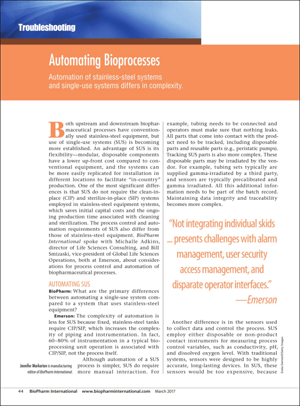For those not in the pharmaceutical and biotech manufacturing industries, if you ever visit one of these facilities you’ll be struck by the clean, shiny stainless steel vessels and piping. Given the importance of hygiene in the production of medicines, most processes include clean-in-place (CIP) and sterilize-in-place operations (SIP). The capital costs and ongoing time requirements for this stainless-steel equipment and CIP and SIP system operations is not insignificant.
In a BioPharm International article, Automating Bioprocesses, author J. Markarian interviews Emerson’s Michalle Adkins and Bill Smizaski to discuss single-use systems (SUS).These are a trend in helping reduce capital project costs and in avoiding the ongoing time requirements of CIP and SIP operations.
When asked about the primary differences of SUS versus conventional approaches, Michalle and Bill noted that the:
…complexity of automation is less for SUS because fixed, stainless-steel tanks require CIP/SIP, which increases the complexity of piping and instrumentation. In fact, 60–80% of instrumentation in a typical bioprocessing unit operation is associated with CIP/SIP, not the process itself.
 SUS does create some of its own set of challenges, because it requires:
SUS does create some of its own set of challenges, because it requires:
…more manual interaction. For example, tubing needs to be connected and operators must make sure that nothing leaks. All parts that come into contact with the product need to be tracked, including disposable parts and reusable parts (e.g., peristatic pumps). Tracking SUS parts is also more complex. These disposable parts may be irradiated by the vendor.
From a process instrumentation standpoint, SUS:
…employ either disposable or non-product contact instruments for measuring process control variables, such as conductivity, pH, and dissolved oxygen level. With traditional systems, sensors were designed to be highly accurate, long-lasting devices. In SUS, these sensors would be too expensive, because the sensor only needs to last for one batch. Disposable sensors are available today that are less expensive, but in some cases, are not accurate or reliable enough.
When asked about how to track single-use material data, they responded [hyperlink added]:
Manufacturing execution systems (MES) that implement MOM [manufacturing operations management] can be designed to track both process material consumption and generation as well as single-use (e.g., tubing, instruments) and reusable components consumption for material traceability purposes.
Michalle and Bill described some challenges in the trend toward continuous manufacturing compared with traditional batch manufacturing:
The control strategy and automation are important in continuous manufacturing. The keys to successful continuous manufacturing include synchronizing unit operations into one process, defining the process in such a way to quickly achieve steady state, and managing disruptions to the process automatically. In addition, good process analytical technology (PAT) and ‘soft sensors’ (i.e., predicting values based on modeling) are important to ensure product quality. It is important to understand how disturbances affect the process and the product including how residence time would be used to track materials during a change or upset in the process.
Read the article for more on their thoughts about skid-by-skid automation versus integrated automation across the process and how the Internet of Things will impact and enhance automation.
You can also connect and interact with other pharmaceutical and biotech manufacturing experts in the Life Sciences group in the Emerson Exchange 365 community.


